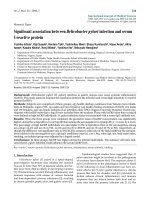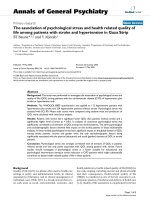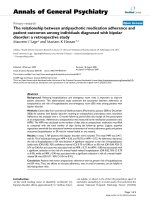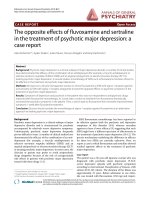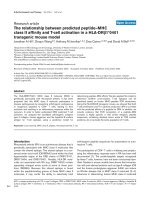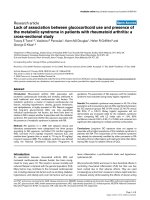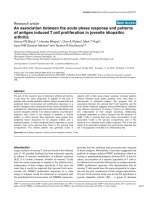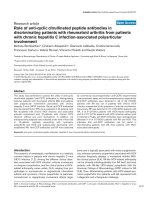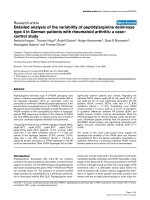Báo cáo y học: "The association between disease activity and NT-proBNP in 238 patients with rheumatoid arthritis: a 10-year longitudinal study" pptx
Bạn đang xem bản rút gọn của tài liệu. Xem và tải ngay bản đầy đủ của tài liệu tại đây (145.07 KB, 7 trang )
Open Access
Available online />Page 1 of 7
(page number not for citation purposes)
Vol 10 No 3
Research article
The association between disease activity and NT-proBNP in 238
patients with rheumatoid arthritis: a 10-year longitudinal study
Sella A Provan
1
, Kristin Angel
2,3
, Sigrid Ødegård
1
, Petter Mowinckel
1
, Dan Atar
2,3
and
Tore K Kvien
1,2
1
Department of Rheumatology, Diakonhjemmet Hospital, Box 23 Vindern, N-0319 Oslo, Norway
2
Faculty of Medicine, University of Oslo, Pb1018 0316 Oslo, Norway
3
Aker University Hospital, Division of Cardiology, University of Oslo, Trondheimsveien 235, 0514 Oslo, Norway
Corresponding author: Sella A Provan,
Received: 29 Jan 2008 Revisions requested: 13 Feb 2008 Revisions received: 12 May 2008 Accepted: 23 Jun 2008 Published: 23 Jun 2008
Arthritis Research & Therapy 2008, 10:R70 (doi:10.1186/ar2442)
This article is online at: />© 2008 Provan et al.; licensee BioMed Central Ltd.
This is an open access article distributed under the terms of the Creative Commons Attribution License ( />),
which permits unrestricted use, distribution, and reproduction in any medium, provided the original work is properly cited.
Abstract
Introduction Disease activity in patients with rheumatoid
arthritis (RA) is associated with increased cardiovascular
morbidity and mortality, of which N-terminal pro-brain natriuretic
peptide (NT-proBNP) is a predictor. Our objective was to
examine the cross-sectional and longitudinal associations
between markers of inflammation, measures of RA disease
activity, medication used in the treatment of RA, and NT-proBNP
levels (dependent variable).
Methods Two hundred thirty-eight patients with RA of less than
4 years in duration were followed longitudinally with three
comprehensive assessments of clinical and radiographic data
over a 10-year period. Serum samples were frozen and later
batch-analyzed for NT-proBNP levels and other biomarkers.
Bivariate, multivariate, and repeated analyses were performed.
Results C-reactive protein (CRP) levels at baseline were cross-
sectionally associated with NT-proBNP levels after adjustment
for age and gender (r
2
adjusted = 0.23; P < 0.05). At the 10-
year follow-up, risk factors for cardiovascular disease were
recorded. Duration of RA and CRP levels were independently
associated with NT-proBNP in the final model that was adjusted
for gender, age, and creatinine levels (r
2
adjusted = 0.38; P <
0.001). In the longitudinal analyses, which adjusted for age,
gender, and time of follow-up, we found that repeated measures
of CRP predicted NT-proBNP levels (P < 0.001).
Conclusion CRP levels are linearly associated with levels of NT-
proBNP in cross-sectional and longitudinal analyses of patients
with RA. The independent associations of NT-proBNP levels
and markers of disease activity with clinical cardiovascular
endpoints need to be further investigated.
Introduction
Patients with rheumatoid arthritis (RA) have a two- to three-
fold increase in cardiovascular mortality and morbidity [1,2].
Several studies have reported an association between dis-
ease activity and cardiovascular mortality [3-5]. Population-
based studies have also shown an increased prevalence of
congestive heart failure (CHF) in patients with RA compared
with healthy controls and patients with osteoarthritis [6,7].
Measures of disease activity and severity such as C-reactive
protein (CRP), disability index, pain, and global severity are
associated with an increased odds ratio for both concurrent
and subsequent CHF [6,8].
The level of N-terminal pro-brain natriuretic peptide (NT-
proBNP) predicts cardiac mortality and morbidity in the gen-
eral population as well as in cohorts of patients with heart fail-
ure and stable coronary heart disease [9-12]. NT-proBNP, the
biologically inactive N-terminal fragment of the active hormone
BNP, has a longer half-life than the active hormone and is a via-
ble biomarker of cardiovascular disease (CVD) [13]. In the
healthy heart, the main site of BNP production is in the atrial
cardiomyocytes, but as the heart fails fetal gene programs are
AIMS1 = Arthritis Impact Measurement Scales 1; anti-CCP = anti-cyclic citrullinated peptide antibody; BMI = body mass index; BNP = brain natriu-
retic peptide; CHF = congestive heart failure; CI = confidence interval; COX-2 = cyclooxygenase-2; CRP = C-reactive protein; CVD = cardiovascular
disease; DAS28 = disease activity score of 28 joints; DMARD = disease-modifying anti-rheumatic drug; ELISA = enzyme-linked immunosorbent
assay; HAQ = Stanford Health Assessment Questionnaire; NSAID = non-steroidal anti-inflammatory drug; NT-proBNP = N-terminal pro-brain natriu-
retic peptide; RA = rheumatoid arthritis; RF = rheumatoid factor; SD = standard deviation; Sharp score = van der Heijde modified Sharp criteria; TNF
= tumor necrosis factor.
Arthritis Research & Therapy Vol 10 No 3 Provan et al.
Page 2 of 7
(page number not for citation purposes)
activated and the ventricular myocardium becomes the main
site of BNP production, releasing the peptide in response to
stretch or ischemia [9,14].
The associations between clinical and laboratory markers of
RA disease activity and levels of NT-proBNP have not been
examined. There is also a lack of knowledge on the relationship
between exposure to drugs used in the treatment of RA (glu-
cocorticoids, disease-modifying anti-rheumatic drugs
[DMARDs], non-steroidal anti-inflammatory drugs [NSAIDs],
and cyclooxygenase-2 [COX-2] inhibitors) and NT-proBNP
levels in patients with RA. Our objective, therefore, was to
examine the cross-sectional and longitudinal associations
between markers of inflammation, RA disease activity, medica-
tion used, and NT-proBNP levels (dependent variable).
Materials and methods
Patients
We followed 238 patients with RA of less than 4 years in dura-
tion longitudinally with comprehensive assessments of clinical
and radiographic data at baseline and after 5 and 10 years
[15]. The patients had all been recruited to the EUropean
Research on Incapacitating DIsease and Social Support
(EURIDISS) project, which was initially established in 1991.
The project has been approved by the Norwegian Regional
Committee for Research Ethics. All patients have signed an
informed consent form on inclusion and at each follow-up
assessment. At baseline, mean (range) age was 51.6 years
(23 to 70), mean (standard deviation, SD) disease duration
was 2.3 years (1.2), and 73.5% were female. Serum samples
were collected from 237 patients at baseline, 126 patients
after 5 years, and 145 after 10 years. Eighty-nine patients
were lost to follow-up at the 10-year visit (42 declined to par-
ticipate, 5 had moved out of the area, 35 had died, and 7 gave
other reasons not to participate).
Measures of disease activity
Disease activity was measured by joint tenderness, which was
assessed at all examinations, and the Ritchie score was calcu-
lated [16]. Swollen joint counts were included at the 5- and
10-year assessments; that is, the disease activity score of 28
joints (DAS28) was not available from the baseline visit [17].
Surrogate measures of cumulative disease activity were health
status and joint destruction. Health status was measured by
the self-administered Stanford Health Assessment Question-
naire (HAQ) and the Arthritis Impact Measurement Scales 1
(AIMS1) [18,19]. Joint destruction was measured by radio-
graphic damage of the hands and scored according to the van
der Heijde modified Sharp criteria (referred to below as the
Sharp score) [20]. Comorbidities were recorded by a trained
study nurse at the 5- and 10-year follow-ups using a checklist
modified from AIMS1 concerning the presence of 16 possible
comorbidities. One of these items addresses the presence of
angina, myocardial infarction, or other cardiac diseases. At the
10-year follow-up, known risk factors of CVD (hypertension,
cholesterol, smoking, and creatinine) were also recorded. The
use of NSAIDs, DMARDs, and glucocorticoids was recorded
by the study nurse at all assessments (the use of COX-2 inhib-
itors was recorded only at the 10-year follow-up).
Biomarkers
NT-proBNP was measured using a Modular E 170 device
(Roche Diagnostics, Mannheim, Germany). The erythrocyte
sedimentation rate was analyzed by the Westergren method at
the time of examination, whereas the other biological markers
were analyzed from frozen serum or plasma anti-cyclic citrulli-
nated peptide antibody (anti-CCP) by enzyme-linked immuno-
sorbent assay (ELISA) (Inova Diagnostics, San Diego, CA,
USA) and CRP by phyCardioPhase high-sensitivity CRP
nefelometri (Dade Behring, now part of Siemens AG, Munich,
Germany). Rheumatoid factor (RF) IgM was analyzed using
the ELISA method [21].
Statistical analyses
NT-proBNP levels were dichotomized according to the
national gender- and age-adjusted reference levels modified
from Roche Diagnostics guidelines [22] (female: < 50 years of
age, NT-proBNP ≤ 20 pmol/L; 50 to 70 years of age, ≤ 30
pmol/L; > 70 to 80 years of age, ≤ 100 pmol/L, and > 80 years
of age, ≤ 200 pmol/L; male: < 50 years of age, NT-proBNP ≤
10 pmol/L; 50 to 70 years of age, ≤ 20 pmol/L; > 70 to 80
years of age, ≤ 60 pmol/L, and > 80 years of age, ≤ 100 pmol/
L). Groups were compared using the χ
2
and Mann-Whitney U
tests as appropriate.
In the regression analyses, NT-proBNP was entered as a con-
tinuous dependent variable and was log-transformed to obtain
normality. The presented β-coefficients have been trans-
formed from the log value. All other variables were entered
untransformed, and all analyses were adjusted for age and
gender. The baseline cross-sectional associations between
demographic, disease activity, and severity variables (gender,
age, CRP, Sharp score of hands, Ritchie score, HAQ disease
duration, RF IgM, anti-CCP, and use of DMARDs, steroids, or
NSAIDs) and NT-proBNP levels were explored in bivariate lin-
ear regression analyses. Variables that were associated (P <
0.10) with NT-proBNP were then entered into a multivariate
linear regression model and subsequently removed in a step-
wise manner according to levels of significance. These ana-
lytic procedures were also applied to the cross-sectional data
from the 10-year follow-up examination, which gave the oppor-
tunity of controlling not only for cardiovascular risk factors,
including body mass index (BMI) and creatinine levels, but also
for the presence of self-reported CVD.
Mixed model linear regression was used to examine longitudi-
nal associations [23]. This is a longitudinal linear regression
analysis that controls for multiple testing of the same patient
by modelling the covariance between the repeated measure-
ments of each individual as a clustered random effect. An
Available online />Page 3 of 7
(page number not for citation purposes)
unstructured covariance matrix was used in our analysis
assuming that the correlation for each level of within-subject
factors is different. The intra-subject variance is then used to
calculate the standard error of the regression coefficient. The
mixed model procedure deals with missing values by assum-
ing them to be missing at random without removing the individ-
ual from the dataset. We investigated the change in NT-
proBNP levels over time and examined associations between
measures of inflammation, RA disease activity, medication
taken, known CVD risk factors, and NT-proBNP (dependent
variable). All analyses were performed using SPSS version 14
(SPSS Inc., Chicago, IL, USA). P values of less than 0.05 were
considered significant.
Results
At baseline, 35 patients had pathological levels of NT-proBNP.
Disease characteristics were similar between these sub-
groups (normal versus elevated NT-proBNP), although the
group with elevated NT-proBNP levels had significantly higher
CRP levels (Table 1). CRP levels at baseline were significantly
associated with NT-proBNP in the linear regression analyses
(Table 2). This significant association was also maintained in
the multivariate linear regression analyses, which included the
interaction between age and gender as an effect modifier. The
use of DMARDs, NSAIDs, or glucocorticoids was not signifi-
cantly associated with NT-proBNP levels. The analysis was
repeated with glucocorticoid use dichotomized according to a
dosage greater than or less than 7.5 mg (P = 0.189).
At the 10-year follow-up examination, age, gender, BMI, creat-
inine, CRP, and disease duration were significantly associated
with NT-proBNP levels (Table 3). Consistent with our baseline
analyses, CRP and NT-proBNP levels remained significantly
associated in the multivariate analysis. The significant associ-
ation between disease duration and NT-proBNP levels was
also maintained. The model was also valid if self-reported CVD
was entered as a covariate (β coefficient for CVD 1.65, 95%
confidence interval [CI] 1.15 to 2.37; P = 0.007). The pres-
ence of hypertension, smoking status, and prevalent use of
glucocorticoids, DMARDs (including subgroups of tumor
necrosis factor [TNF] inhibitors and methotrexate users),
COX-2 inhibitors, or NSAIDs was not significantly associated
with NT-proBNP levels (data not shown).
In the repeated mixed model analysis, several markers of dis-
ease activity were associated with NT-proBNP levels, but after
multivariate adjustment for time of follow-up, only CRP
remained a significant predictor in the final model (Table 4).
NT-proBNP levels increased between each follow-up visit and
the interactions between age and gender and gender and time
of follow-up were significant effect modifiers. The model
remained significant if self-reported CVD at the 10-year follow-
up was entered as a covariate (β coefficient for CVD 1.48,
95% CI 1.11 to 1.98; P = 0.008).
Discussion
NT-proBNP has been shown to be an independent predictor
of cardiovascular morbidity and mortality [9-11], and disease
activity in RA correlates with mortality, CVD, and CHF [5,6].
Hence, it is of interest to investigate how markers of inflamma-
tion and disease activity are related to NT-proBNP in a longi-
tudinal perspective. We found significant cross-sectional and
longitudinal associations between CRP and levels of NT-
proBNP in this cohort of RA patients with less than 4 years of
disease duration at inclusion. CRP remained an independent
predictor of NT-proBNP levels after controlling for known car-
diovascular risk factors and the presence of self-reported CVD
at the 10-year follow-up and in the longitudinal analyses.
Table 1
Baseline characteristics with comparison between patients with pathological versus normal levels of NT-proBNP
All patients NT-proBNP-negative
a
n = 202 NT-proBNP-positive
a
n = 35 P value
Age, years 51.9 (13.0) 51.4 (12.9) 54.3 (13.7) 0.17
Female gender 175 (73.5) 151 (74.8) 23 (65.7) 0.26
Disease duration, years 2.3 (1.2) 2.2 (1.1) 2.4 (1.3) 0.41
RF IgM-positive, ≥ 25 114 (47.9) 97 (48.0) 16 (45.7) 0.80
Anti-CCP-positive, ≥ 25 144 (60.5) 125 (61.9) 18 (51.4) 0.24
Sharp score 6.8 (11.8) 6.8 (12.3) 6.5 (8.1) 0.20
C-reactive protein, mg/L 9.9 (12.7) 9.2 (11.8) 13.9 (15.8) 0.05
DMARD user 124 (52.1) 104 (51.5) 19 (54.3) 0.76
NSAID user 109 (45.8 92 (45.5) 17 (48.6) 0.74
Glucocorticoid user, oral 65 (27.2) 51 (25.2) 14 (40) 0.07
Values are presented as mean (standard deviation) for continuous variables and as number (percentage) for counts.
a
Age- and gender-adjusted reference levels. anti-
CCP, anti-cyclic citrullinated peptide antibody; DMARD, disease-modifying anti-rheumatic drug; NSAID, non-steroidal anti-inflammatory drug; NT-proBNP, N-terminal
pro-brain natriuretic peptide; RF, rheumatoid factor; Sharp score, van der Heijde modified Sharp criteria.
Arthritis Research & Therapy Vol 10 No 3 Provan et al.
Page 4 of 7
(page number not for citation purposes)
Our findings are intriguing as the relationship between BNP/
NT-proBNP values and the risk of CVD may not be dependent
on a threshold value of BNP/NT-proBNP but rather represents
a continuum [11,24]. Wang and colleagues [11] found that a
single measurement of BNP provided prognostic information
in an unselected population of 3,346 persons without heart
failure followed for a mean of 5.2 years. An increase of BNP
levels by 1 SD was associated with a 77% increased risk of
developing heart failure and a 28% increased risk of a first car-
diovascular event [11]. BNP has been validated as a marker of
CVD in patients with RA. Harney and colleagues [25] found
that BNP levels were significantly higher in 26 patients with
RA than in controls and correlated with end diastolic volume
(r
2
= 0.83), end systolic volume (r
2
= 0.62), and left ventricular
mass (r
2
= 0.4). Levels of NT-proBNP have been found to cor-
relate closely with BNP (r = 0.9; P < 0.001) [24].
Increased levels of inflammatory markers are associated with
an increased risk of cardiovascular morbidity and mortality
[26,27]. We found that CRP was significantly associated with
levels of NT-proBNP at all time points. Flares in inflammatory
activity might be better predictors of cardiovascular events
than long-term exposure to low-grade inflammation. Indeed,
there is evidence that the initiation of CHF in RA patients is
preceded by a flare in disease activity [8]. Radiographic pro-
gression and the HAQ score are surrogate measures of cumu-
lative disease activity, although we acknowledge that there are
wide inter-individual variations [28-31]. We found no signifi-
cant association between these measures and NT-proBNP
levels in our multivariate longitudinal analyses. Previous
reports on the association between joint destruction and CVD
in RA have been inconsistent; Wållberg-Jonsson and col-
leagues [5] demonstrated that early progression of erosions
increased the risk of cardiovascular events. Solomon and col-
leagues [1], on the other hand, did not find that joint erosions
were significantly associated with cardiovascular death or
myocardial infarction in multivariate analyses. However, we did
find disease duration to be significantly associated with NT-
proBNP levels at the 10-year cross-sectional analysis. As all
patients had a disease duration of 4 years or less at inclusion,
the correlation with NT-proBNP levels after 10 years is difficult
to interpret. A link between RA disease duration and increased
CVD risk can be questioned. In the Rochester cohort, no asso-
ciation was found between risk of heart failure or cardiovascu-
lar death and RA disease duration [7,32], nor did Book and
colleagues [33] find an association between disease duration
and mortality.
To our knowledge, no previous study has examined the asso-
ciation between markers of inflammation in RA and BNP/NT-
proBNP. It could be argued that the association between CRP
and NT-proBNP identified in our study is a consequence of the
inflammatory nature of ventricular remodelling. Patients with
RA are not only exposed to systemic inflammation from their
Table 2
Cross-sectional associations at baseline between NT-proBNP (dependent variable) and rheumatoid arthritis disease activity
Adjusted linear regression Multivariate linear regression
β coefficient P value β coefficient P value
Age 1.02 (1.01–1.03) < 0.001 1.009 (1.00–1.02) 0.04
Male gender 0.74 (0.59–0.95) 0.02 0.10 (0.04–0.23) < 0.001
C-reactive protein
a
1.01 (1.01–1.02) 0.002 1.01 (1.01–1.02) 0.001
RF IgM-positive
a, b
0.96 (0.79–1.17) 0.67
Anti-CCP-positive
a, b
0.90 (0.74–1.10) 0.30
Gluocorticoid user
a, b
1.17 (0.94–1.48) 0.16
DMARD user
a, b
1.04 (0.85–1.26) 0.71
NSAID user
a, b
0.97 (0.80–1.19) 0.81
Ritchie score
a
1.01 (0.99–1.03) 0.21
HAQ
a
1.06 (0.90–1.24) 0.47
Sharp score
a
1.00 (0.99–1.02) 0.93
Disease duration
a
0.99 (0.91–1.08) 0.82
Age × male gender 1.04 (1.02–1.05) < 0.001
R
2
adjusted 0.23 < 0.05
a
Age- and gender-adjusted;
b
dichotomized variable. anti-CCP, anti-cyclic citrullinated peptide antibody; DMARD, disease-modifying anti-rheumatic drug; HAQ,
Stanford Health Assessment Questionnaire; NSAID, non-steroidal anti-inflammatory drug; NT-proBNP, N-terminal pro-brain natriuretic peptide; RF, rheumatoid factor;
Ritchie score, Ritchie articular index; Sharp score, van der Heijde modified Sharp criteria.
Available online />Page 5 of 7
(page number not for citation purposes)
Table 3
Cross-sectional associations at the 10-year follow-up between NT-proBNP (dependent variable) and rheumatoid arthritis disease
activity, controlling for cardiovascular risk factors
Adjusted linear regression Multivariate linear regression
β coefficients P value β coefficients P value
Age 1.04 (1.03–1.05) < 0.001 1.04 (1.03–1.05) < 0.001
Male gender 0.92 (0.64–1.31) 0.64 0.76 (0.53–1.04) 0.09
Body mass index
a
0.96 (0.93–0.98) 0.001
Atherogenic index
a
0.95 (0.86–1.04) 0.25
Creatinine
a
1.02 (1.01–1.02) 0.001 1.01 (1.00–1.02) 0.04
C-reactive protein
a
1.01 (1.0–1.03) 0.06 1.02 (1.00–1.02) 0.03
RF IgM-positive
a, b
0.92 (0.72–1.19) 0.53
Anti-CCP-positive
a, b
1.14 (0.88–1.45) 0.33
Ritchie score
a
1.00 (0.99–1.01) 0.87
DAS28
a
1.05 (0.96–1.16) 0.27
HAQ
a
1.15 (0.94–1.41) 0.17
Sharp score
a
1.002 (1.00–1.01) 0.17
Disease duration
a
1.14 (1.02–1.27) 0.02 1.15 (1.03–1.27) 0.01
R
2
adjusted 0.38 < 0.001
a
Age- and gender-adjusted;
b
dichotomized variable. anti-CCP, anti-cyclic citrullinated peptide antibody; DAS28, disease activity score of 28 joints; HAQ, Stanford
Health Assessment Questionnaire; NT-proBNP, N-terminal pro-brain natriuretic peptide; RF, rheumatoid factor; Ritchie score, Ritchie articular index; Sharp score, van
der Heijde modified Sharp criteria.
Table 4
Mixed model repeated measure linear regression showing the association between NT-proBNP (dependent variable) and markers
of disease activity and treatment
Adjusted linear regression (CI) Multivariate linear regression (CI)
β coefficients (CI) P value β coefficients (CI) P value
Age 1.03 (1.02–1.03) < 0.001 1.02 (1.01–1.02) < 0.001
Male gender 0.81 (0.64–1.01) 0.06 0.12 (0.05–0.26) < 0.001
C-reactive protein
a
1.01 (1.01–1.02) < 0.001 1.01 (1.01–1.02) < 0.001
HAQ
a
1.12 (1.00–1.27) 0.06
Prednisolone
a, b
1.20 (1.03–1.41) 0.02
NSAID
a, b
0.90 (0.79–1.04) 0.14
DMARD
a, b
0.95 (0.83–1.09) 0.49
Sharp score
a
1.01 (1.00–1.01) 0.001
Ritchie score
a
1.01 (1.00–1.02) 0.01
Time 1.04 (1.03–1.06) < 0.001 1.03 (1.02–1.05) < 0.001
Time × male gender 1.04 (1.01–1.07) 0.01
Age × male gender 1.03 (1.02–1.05) 0.01
a
Age- and gender-adjusted;
b
dichotomized variable. CI, confidence interval; DMARD, disease-modifying anti-rheumatic drug; HAQ, Stanford Health Assessment
Questionnaire; NSAID, non-steroidal anti-inflammatory drug; NT-proBNP, N-terminal pro-brain natriuretic peptide; Ritchie score, Ritchie articular index; Sharp score,
van der Heijde modified Sharp criteria.
Arthritis Research & Therapy Vol 10 No 3 Provan et al.
Page 6 of 7
(page number not for citation purposes)
arthritic disease, the failing heart itself may be invaded by
peripheral blood mononuclear cells that participate in left ven-
tricular remodelling. These and other inflammatory cells
release TNF-α and interleukin-6, thereby increasing CRP lev-
els through upregulation of hepatic synthesis [27].
The strength of the present study is the prospective longitudi-
nal design with regular clinical examinations, blood sampling
with subsequent batch analyses, and documentation of radio-
graphic progression. NT-proBNP has been shown to tolerate
routine laboratory handling and may be analyzed from frozen
sera [10,34]. The validity of our model is supported by the
association between NT-proBNP levels and self-reported
CVD. Furthermore, in agreement with previous studies, creat-
inine levels predict NT-proBNP in the final model. NT-proBNP
is metabolized in the renal proximal tubule, and reduced renal
function partially accounts for the age-related increase in NT-
proBNP levels in the general population [14,35]. We found
BMI to be inversely correlated with NT-proBNP levels in the
adjusted bivariate analyses although it did not reach signifi-
cance in the multivariate analysis. Other studies have con-
firmed the inverse relationship between BMI and NT-proBNP
levels [36].
This study has several shortcomings. Two hundred thirty-eight
patients were included at baseline, and 145 completed the
10-year follow-up. The small scale of this study is a limitation
in the analyses. CVD in RA was not a major focus when the
cohort was established, and information relating to cardiovas-
cular comorbidity, smoking, concomitant medication, blood
pressure, or BMI was not recorded at baseline. The presence
of CVD was recorded by a questionnaire at the 10-year follow-
up and we did not have the opportunity to verify the diagnosis
by searching the medical records. Cause of death for the 35
patients who died during the study was not recorded. Thus,
we considered that the data were not sufficiently robust to
allow an explorative analysis of how levels of NT-proBNP pre-
dict future CVD. However, the patients were requested to
report current medication. There was perfect agreement
between self-reported CVD and the reported prescription of
medication typically used to treat CVD, such as anti-hyperten-
sive drugs, anti-platelet agents, or nitrates, allowing for an
internal consistency check.
Conclusion
CRP levels were linearly associated with levels of NT-proBNP
in this cross-sectional and longitudinal study of 238 patients
with RA. Further studies are needed to elucidate how this
biomarker can be implemented in clinical decision making in
RA.
Competing interests
The authors declare that they have no competing interests.
Authors' contributions
SAP developed the study, performed the analyses, and
drafted the manuscript. KA participated in the development of
the study and in the drafting of the manuscript. SØ partici-
pated in the data collection and the drafting of the manuscript.
PM gave statistical advice and helped in the drafting of the
manuscript. DA conceived the study, participated in its design
and development, and helped in the drafting of the manuscript.
TKK conceived the study, participated in its design and devel-
opment, and helped in the drafting of the manuscript. All
authors have read and approved the manuscript.
Acknowledgements
We thank Roche Diagnostics (Mannheim, Germany) for providing the
kits for NT-proBNP testing (Bernhard Trauth), Inge Christoffer Olsen for
statistical help, and Ludvig Daae for helpful comments. This study was
supported by grants from the Eastern Norway Regional Health Authority,
The Norwegian Rheumatism Association, The Norwegian Women Pub-
lic Health Association, the Grethe Harbitz Legacy, and the Marie and
Else Mustad's Legacy.
References
1. Solomon DH, Karlson EW, Rimm EB, Cannuscio CC, Mandl LA,
Manson JE, Stampfer MJ, Curhan GC: Cardiovascular morbidity
and mortality in women diagnosed with rheumatoid arthritis.
Circulation 2003, 107:1303-1307.
2. del Rincón ID, Williams K, Stern MP, Freeman GL, Escalante A:
High incidence of cardiovascular events in a rheumatoid
arthritis cohort not explained by traditional cardiac risk factors.
Arthritis Rheum 2001, 44:2737-2745.
3. Turesson C, McClelland RL, Christianson TJ, Matteson EL: Severe
extra-articular disease manifestations are associated with an
increased risk of first ever cardiovascular events in patients
with rheumatoid arthritis. Ann Rheum Dis 2007, 66:70-75.
4. Farragher TM, Lunt M, Bunn DK, Silman AJ, Symmons DP: Early
functional disability predicts both all-cause and cardiovascular
mortality in people with inflammatory polyarthritis: results
from the Norfolk Arthritis Register. Ann Rheum Dis 2007,
66:486-492.
5. Wållberg-Jonsson S, Johansson H, Ohman ML, Rantapää-Dahl-
qvist S: Extent of inflammation predicts cardiovascular disease
and overall mortality in seropositive rheumatoid arthritis. A ret-
rospective cohort study from disease onset. J Rheumatol
1999, 26:2562-2571.
6. Wolfe F, Michaud K: Heart failure in rheumatoid arthritis: rates,
predictors, and the effect of anti-tumor necrosis factor ther-
apy. Am J Med 2004, 116:305-311.
7. Nicola PJ, Maradit-Kremers H, Roger VL, Jacobsen SJ, Crowson
CS, Ballman KV, Gabriel SE: The risk of congestive heart failure
in rheumatoid arthritis: a population-based study over 46
years. Arthritis Rheum 2005, 52:412-420.
8. Maradit-Kremers H, Nicola PJ, Crowson CS, Ballman KV, Jacob-
sen SJ, Roger VL, Gabriel SE: Raised erythrocyte sedimentation
rate signals heart failure in patients with rheumatoid arthritis.
Ann Rheum Dis 2007, 66:76-80.
9. Bibbins-Domingo K, Ansari M, Schiller NB, Massie B, Whooley
MA: B-type natriuretic peptide and ischemia in patients with
stable coronary disease: data from the Heart and Soul study.
Circulation 2003, 108:2987-2992.
10. Kragelund C, Gronning B, Kober L, Hildebrandt P, Steffensen R:
N-terminal pro-B-type natriuretic peptide and long-term mor-
tality in stable coronary heart disease. N Engl J Med 2005,
352:666-675.
11. Wang TJ, Larson MG, Levy D, Benjamin EJ, Leip EP, Omland T,
Wolf PA, Vasan RS:
Plasma natriuretic peptide levels and the
risk of cardiovascular events and death. N Engl J Med 2004,
350:655-663.
12. Bettencourt P, Azevedo A, Pimenta J, Frioes F, Ferreira S, Ferreira
A: N-terminal-pro-brain natriuretic peptide predicts outcome
Available online />Page 7 of 7
(page number not for citation purposes)
after hospital discharge in heart failure patients. Circulation
2004, 110:2168-2174.
13. Tschope C, Kasner M, Westermann D, Gaub R, Poller WC,
Schultheiss HP: The role of NT-proBNP in the diagnostics of
isolated diastolic dysfunction: correlation with echocardio-
graphic and invasive measurements. Eur Heart J 2005,
26:2277-2284.
14. McKie PM, Burnett JC Jr: B-type natriuretic peptide as a biomar-
ker beyond heart failure: speculations and opportunities.
Mayo Clin Proc 2005, 80:1029-1036.
15. Smedstad LM, Vaglum P, Kvien TK, Moum T: The relationship
between self-reported pain and sociodemographic variables,
anxiety, and depressive symptoms in rheumatoid arthritis. J
Rheumatol 1995, 22:514-520.
16. Ritchie DM, Boyle JA, McInnes JM, Jasani MK, Dalakos TG, Grieve-
son P, Buchanan WW: Clinical studies with an articular index
for the assessment of joint tenderness in patients with rheu-
matoid arthritis. Q J Med 1968, 37:393-406.
17. Prevoo ML, van 't Hof MA, Kuper HH, van Leeuwen MA, Putte LB
van de, van Riel PL: Modified disease activity scores that
include twenty-eight-joint counts. Development and validation
in a prospective longitudinal study of patients with rheumatoid
arthritis. Arthritis Rheum 1995, 38:44-48.
18. Fries JF, Spitz P, Kraines RG, Holman HR: Measurement of
patient outcome in arthritis. Arthritis Rheum 1980, 23:137-145.
19. Meenan RF, Gertman PM, Mason JH: Measuring health status in
arthritis. The arthritis impact measurement scales. Arthritis
Rheum 1980, 23:146-152.
20. Heijde DM van der: Plain X-rays in rheumatoid arthritis: over-
view of scoring methods, their reliability and applicability. Bail-
lieres Clin Rheumatol 1996, 10:435-453.
21. Syversen SW, Gaarder PI, Goll GL, Ødegård S, Haavardsholm
EA, Mowinckel P, Heijde D van der, Landewé R, Kvien TK: High
anti-cyclic citrullinated peptide levels and an algorithm of four
variables predict radiographic progression in patients with
rheumatoid arthritis: results from a 10-year longitudinal study.
Ann Rheum Dis 2008, 67:212-217.
22. Raymond I, Groenning BA, Hildebrandt PR, Nilsson JC, Baumann
M, Trawinski J, Pedersen F: The influence of age, sex and other
variables on the plasma level of N-terminal pro brain natriu-
retic peptide in a large sample of the general population. Heart
2003, 89:745-751.
23. Chan YH: Biostatistics 301A. Repeated measurement analysis
(mixed models). Singapore Med J 2004, 45:456-461.
24. Richards M, Nicholls MG, Espiner EA, Lainchbury JG, Troughton
RW, Elliott J, Frampton CM, Crozier IG, Yandle TG, Doughty R,
MacMahon S, Sharpe N, Christchurch Cardioendocrine Research
Group; Australia-New Zealand Heart Failure Group: Comparison
of B-type natriuretic peptides for assessment of cardiac func-
tion and prognosis in stable ischemic heart disease. J Am Coll
Cardiol 2006, 47:52-60.
25. Harney SM, Timperley J, Daly C, Harin A, James T, Brown MA, Ban-
ning AP, Fox K, Donnelly S, Wordsworth BP: Brain natriuretic
peptide is a potentially useful screening tool for the detection
of cardiovascular disease in patients with rheumatoid arthritis.
Ann Rheum Dis 2006, 65:136.
26. Ridker PM, Buring JE, Cook NR, Rifai N: C-reactive protein, the
metabolic syndrome, and risk of incident cardiovascular
events: an 8-year follow-up of 14 719 initially healthy American
women. Circulation 2003, 107:391-397.
27. Vasan RS, Sullivan LM, Roubenoff R, Dinarello CA, Harris T, Ben-
jamin EJ, Sawyer DB, Levy D, Wilson PW, D'Agostino RB, Fram-
ingham Heart Study: Inflammatory markers and risk of heart
failure in elderly subjects without prior myocardial infarction:
the Framingham Heart Study. Circulation 2003,
107:1486-1491.
28. van Leeuwen MA, van Rijswijk MH, Heijde DM van der, Te Meer-
man GJ, van Riel PL, Houtman PM, Putte LB van De, Limburg PC:
The acute-phase response in relation to radiographic progres-
sion in early rheumatoid arthritis: a prospective study during
the first three years of the disease. Br J Rheumatol 1993,
32(Suppl 3):9-13.
29. Wick MC, Lindblad S, Klareskog L, Van Vollenhoven RF: Relation-
ship between inflammation and joint destruction in early rheu-
matoid arthritis: a mathematical description. Ann Rheum Dis
2004, 63:848-852.
30. van Leeuwen MA, van Rijswijk MH, Sluiter WJ, van Riel PL, Kuper
IH, Putte LB van de, Pepys MB, Limburg PC: Individual relation-
ship between progression of radiological damage and the
acute phase response in early rheumatoid arthritis. Towards
development of a decision support system. J Rheumatol 1997,
24:20-27.
31. Ødegård S, Landewé R, Heijde van der, Kvien TK, Mowinckel P,
Uhlig T: Association of early radiographic damage with
impaired physical function in rheumatoid arthritis: a ten-year,
longitudinal observational study in 238 patients. Arthritis
Rheum 2006, 54:68-75.
32. Maradit-Kremers H, Nicola PJ, Crowson CS, Ballman KV, Gabriel
SE: Cardiovascular death in rheumatoid arthritis: a population-
based study. Arthritis Rheum 2005, 52:722-732.
33. Book C, Saxne T, Jacobsson LT: Prediction of mortality in rheu-
matoid arthritis based on disease activity markers. J Rheuma-
tol 2005, 32:430-434.
34. Hobbs FD, Davis RC, Roalfe AK, Hare R, Davies MK, Kenkre JE:
Reliability of N-terminal pro-brain natriuretic peptide assay in
diagnosis of heart failure: cohort study in representative and
high risk community populations. BMJ 2002, 324:1498.
35. Galasko GI, Lahiri A, Barnes SC, Collinson P, Senior R: What is
the normal range for N-terminal pro-brain natriuretic peptide?
How well does this normal range screen for cardiovascular
disease? Eur Heart J 2005, 26:2269-2276.
36. St Peter JV, Hartley GG, Murakami MM, Apple FS: B-type natriu-
retic peptide (BNP) and N-terminal pro-BNP in obese patients
without heart failure: relationship to body mass index and gas-
tric bypass surgery. Clin Chem 2006, 52:680-685.

